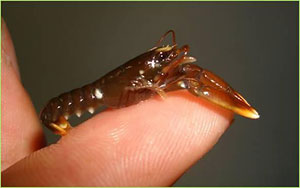

 | |||||||||||
|
|
Journals 2009/2010Jennifer Emblidge
August 18, 2009 This morning I helped Jana with another task. I transferred the lobster tissue samples from their original glass vials into plastic test tubes that she will transfer to Germany. The original samples were placed into 95% ethanol. These samples are from the suction sampling and have been sorted using the method that I previously described to you. After sorting, the lobster tissue samples are placed into ethanol. However, after a short while, the ethanol absorbs the water out of the tissues. It is then necessary to make sure the samples are safe for transport and later genetic analysis. Therefore, the tissues are moved into a fresh vial of 95% ethanol and sealed for Jana to return to Germany with in a few weeks. As a reminder, Jana will be using the tissue samples in order to determine if the lobsters caught during the suction sampling in Penobscot Bay were from the hatchery or they are wild lobsters.
Today is my chance to introduce you to the Wahle Lab technician that I have mentioned many times so far. Charlene Bergeron is a very critical part of the Wahle lab team. She has been a part of the team for the past five years. Two years ago, she decided to return to school and work on her graduate degree in marine biology from the University of Maine. She is looking at lobster growth for her degree and modeling lobster size at age. This work will be used to help determine the age of a lobster by measuring its size. As of yet, no other method has been consistently used to determine the age of a lobster. You can age a fish by counting the growth lines on their otilith. An otilith is an ear bone found near the gill area of a fish. Charlene made the decision to return to her schooling, in order to play a larger role in fisheries conservation effort and participate more in its development and application. Before being employed in the Wahle lab, Charlene held a variety of marine biology positions. She earned her marine biology degree from the University of Santa Cruz in California. After that, she was employed in Hawaii for the United States Geological Survey (USGS) monitoring an invasive ant species. Next, she returned to Santa Cruz to work for the National Marine Fisheries Service (NMS) on salmon. After that, she went to work for a salmon hatchery in Prince William Sound, Alaska. Charlene has many talents she brings to the Wahle lab. I will just mention a few of them. She is very comfortable in the water. I found this out last night when I saw her water skiing skills. She is also a recreational surfer. Most importantly, she is a dive master and certified as a scientific diver. I have had many opportunities already to witness Charlene's skill in the water. I asked Charlene the question, "Why lobsters?" She replied that she really "just fell into it." She picked the field of marine ecology and when she was searching for job positions she found this position and it seemed like it would be right up her alley. Her favorite part of being a marine ecologist is getting to hold a job where she gets to enjoy the outdoors. The most exciting part of her marine ecology career has been all the awesome wildlife encounters she has been able to experience. From my brief stay within the Wahle lab, I can tell that Charlene is a key component to the success of the Wahle lab. You can really tell that she enjoys her job and this excitement and satisfaction spreads to the rest of the lab through her.
|
||||||||||

